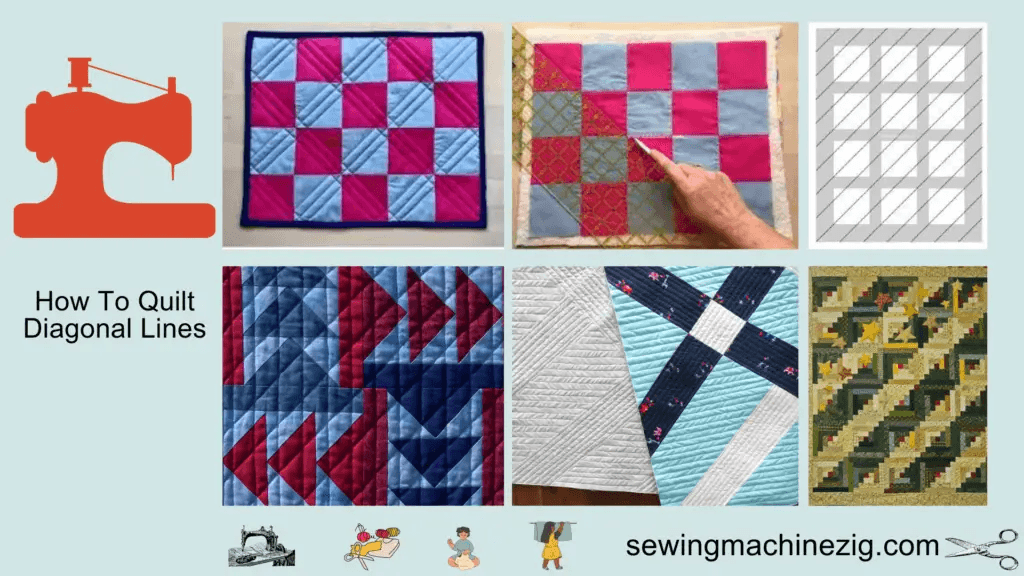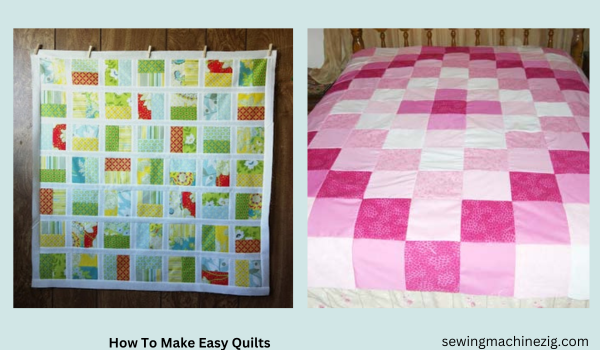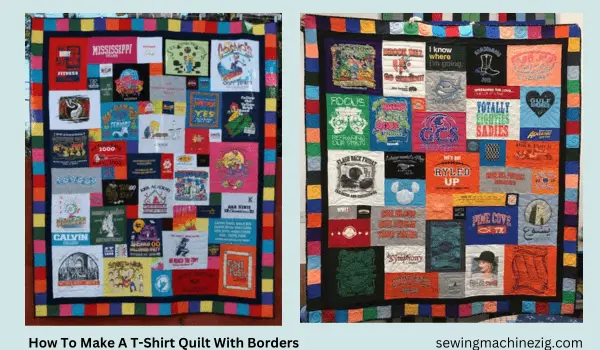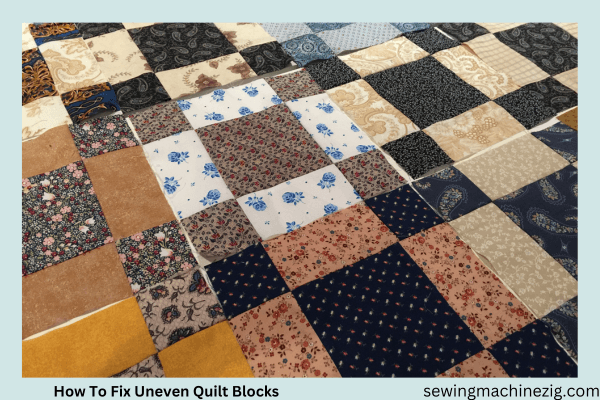
Quilting is a cherished craft that allows individuals to create beautiful and unique textile masterpieces. However, even the most experienced quilters occasionally encounter issues with uneven quilt blocks. Uneven blocks can disrupt the overall appearance of a quilt and may leave quilters feeling frustrated.
Thankfully, there are several techniques you can employ to address and rectify this problem. In this article, we will explore practical steps on how to fix uneven quilt blocks and achieve a more harmonious quilt design.
When it comes to quilting, two factors play a significant role in the quality and aesthetics of your quilt blocks: precision and consistency. Quilt blocks should ideally be uniform in size, shape, and seam allowances to create a visually appealing finished quilt.
It’s not uncommon to encounter uneven quilt blocks during the quilting process. The good news is that there are ways to address this issue and achieve a more harmonious result. how to fix uneven quilt blocks involves employing various techniques such as trimming, adjusting seams, or using sashing and borders strategically.
To address the issue of uneven quilt blocks, a thoughtful approach, and a few corrective techniques can help bring your quilt project back on track.
how to fix uneven quilt blocks, from squaring up blocks to adjusting seams, these methods will allow you to restore balance and create a visually stunning quilt. In this article, We will discuss a detailed guide on how to fix uneven quilt blocks and its related topic.
By following the steps outlined in this article, you’ll be able to transform your uneven blocks into cohesive, well-crafted components that seamlessly fit together.
Materials:
- Quilt Blocks
- Rotary cutter
- Cutting mat
- Quilting ruler
- Sewing machine
- Iron and ironing board
- Seam ripper (optional)
- Pins
Step-By-Step Guide:
Step 1: Assess The Blocks:
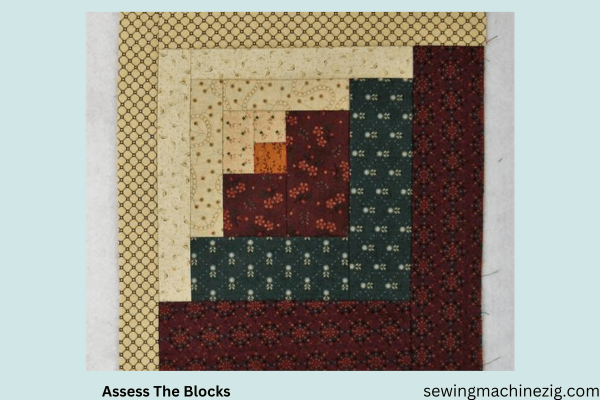
Examine each quilt block to identify areas of unevenness. Look for variations in size, shape, or seam allowances. how to fix uneven quilt blocks requires a systematic approach to address specific issues.
Example: In Block A, the right side measures 10 inches, while the left side measures 10.5 inches.
Step 2: Determine Desired Size:
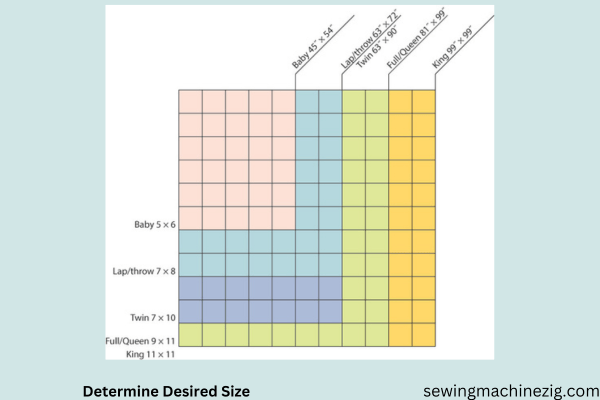
Decide on the desired finished size for your quilt blocks. Measure the smallest dimension of the uneven block to establish the target size.
Example: The desired finished size for Block A is 10 inches on all sides.
Step 3: Trim The Block:
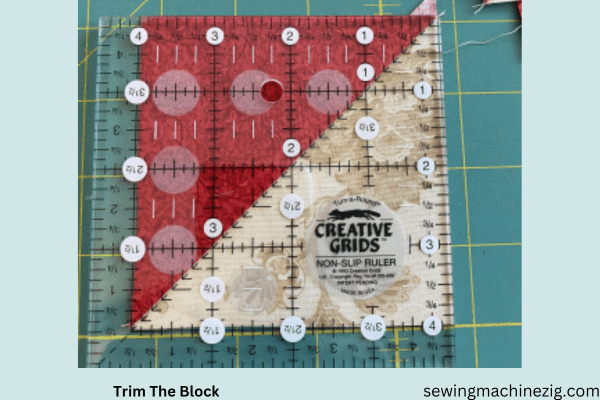
Using a rotary cutter, cutting mat, and quilting ruler, carefully trim the excess fabric from the longer side of the block to match the desired size. Take your time to ensure precise cuts.
Example: Trim the left side of Block A by 0.5 inches to make it 10 inches, aligning it with the right side.
Step 4: Adjust Seams:
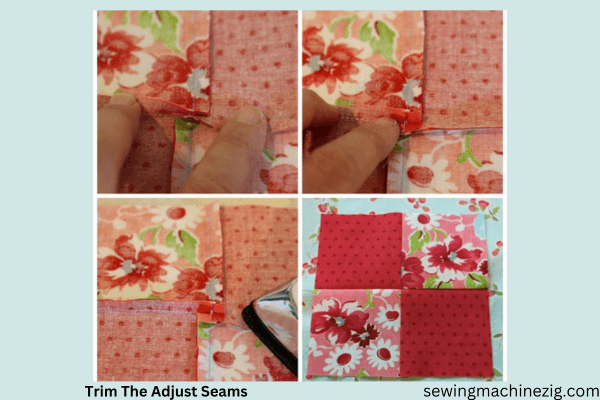
If the unevenness is due to inconsistent seam allowances, adjust the seams by either adding or reducing fabric. Seam ripping may be necessary.
Example: If the longer side of Block A resulted from a wider seam allowance, carefully remove the stitches and re-stitch the seam with a narrower allowance.
Step 5: Press The Block:
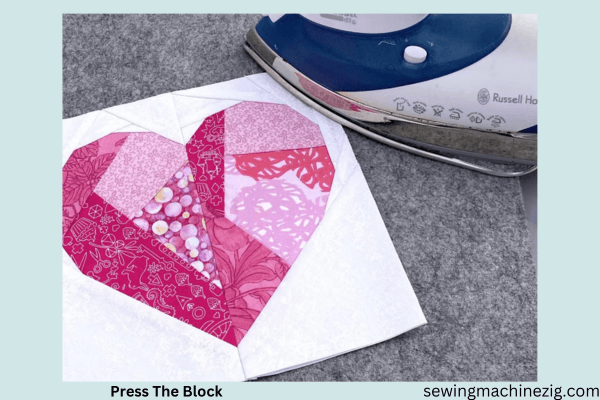
Press the quilt block with an iron to ensure it lies flat and all seams are crisp. This step helps in achieving a professional finish.
Example: After trimming and adjusting the seam, press Block A, paying attention to the seam allowances.
Step 6: Repeat For Other Blocks:
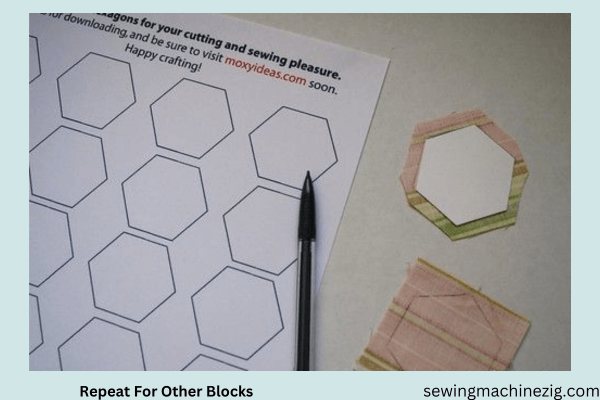
Follow the same steps for all the remaining uneven blocks, addressing their specific issues individually.
Example: If you have Block B with uneven corners, assess the corners, trim if necessary, and adjust seams to achieve consistency.
Step 7: Arrange Blocks:
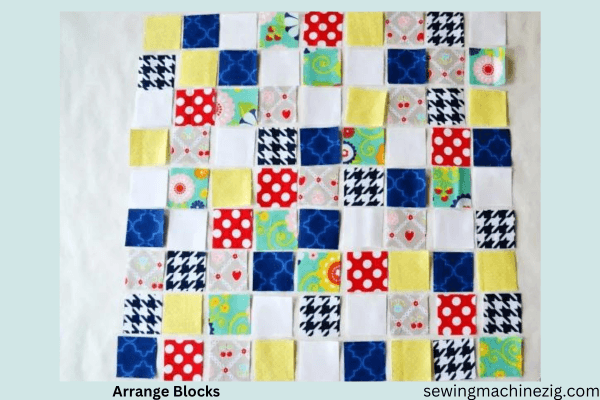
Arrange the fixed blocks in the desired layout, taking care to distribute any minor variations evenly throughout the quilt.
Example: Place Block A and Block B alongside other fixed blocks, ensuring their sizes and shapes align harmoniously.
Step 8: Continue Quilt Construction:
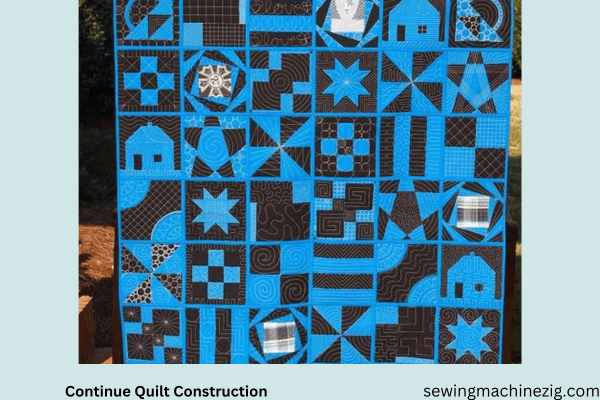
Proceed with constructing your quilt, including adding sashing, borders, and any additional elements as planned. Pay attention to proper seam allowances and block placement to maintain uniformity.
Example: Join Block A, Block B, and other fixed blocks using accurate seam allowances and incorporating sashing or borders to create a cohesive quilt design.
By following these steps and adapting them to your specific quilt blocks, how to fix uneven quilt blocks, you can effectively fix unevenness and create a visually pleasing quilt that showcases your quilting skills. I hope now you understand how to fix uneven quilt blocks.
How To Make It Work When Quilt Tops Aren’t Working?
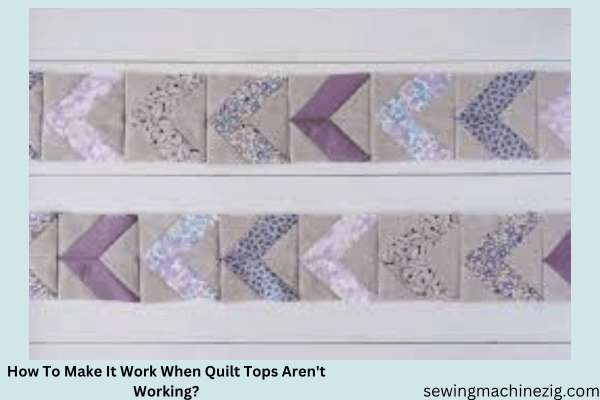
Quilting is a labor of love, but sometimes, despite our best efforts, quilt tops don’t turn out as planned. Whether it’s misaligned blocks, puckered seams, uneven borders, or color imbalances, encountering issues with quilt tops can be frustrating.
However, with some thoughtful problem-solving and careful adjustments, it’s possible to salvage and transform these quilt tops into stunning finished pieces.
In this guide, we’ll explore how to fix uneven quilt block strategies to address common problems with quilt tops, offering practical steps to make them work and turn your quilting vision into a reality.
1. Identify The Issues:
Take a close look at your quilt top and identify the specific issues that are not working. This could include blocks not lining up, fabric puckering, uneven borders, or color imbalances.
2. Assess The Causes:
Determine the root causes behind the issues you’ve identified. This could be due to inaccurate cutting, inconsistent seam allowances, fabric stretching, or design miscalculations.
3. Plan For Modifications:
Based on the identified issues, create a plan for modifications or adjustments to address them. Consider the following methods:
a. Block Adjustments: If blocks aren’t lining up, evaluate the seams and dimensions. Seam allowances may need to be adjusted, or blocks may need to be re-cut or resized.
b. Seam Rip and Re-stitch: If seams are puckering or uneven, carefully remove the problematic stitches using a seam ripper. Then re-stitch with accurate seam allowances, ensuring smooth and flat seams.
c. Borders: If borders are uneven or causing the quilt to warp, measure and trim them as necessary to achieve consistent widths. Consider adding additional piecing or corner adjustments to align the borders properly.
d. Color Corrections: If there are color imbalances or clashes, consider adding additional fabric elements, such as appliqué, to create a cohesive color scheme.
4. Take Incremental Steps:
When making modifications, work in small increments, make adjustments to a specific area, check the overall effect, and then proceed accordingly. This approach allows you to evaluate the impact of each change and make further adjustments as needed.
5. Pressing And Finishing:
Throughout the modification process, ensure you press the quilt top meticulously after each adjustment. This helps set the seams, smooth out any puckering, and creates a neat and professional finish.
6. Seek Feedback And Assistance:
If you’re struggling to make the necessary modifications or unsure about the best course of action, consider seeking advice from experienced quilters or joining online quilting communities. Their insights and suggestions can provide valuable guidance.
Remember, modifying quilt tops requires patience, precision, and an open mind. Embrace the opportunity to learn how to fix uneven quilt blocks from any challenges and use them as a stepping stone to improve your quilting skills. With careful adjustments and attention to detail, you can transform a quilt top that isn’t working into a beautiful finished quilt.
How To Fix Uneven Quilt Rows
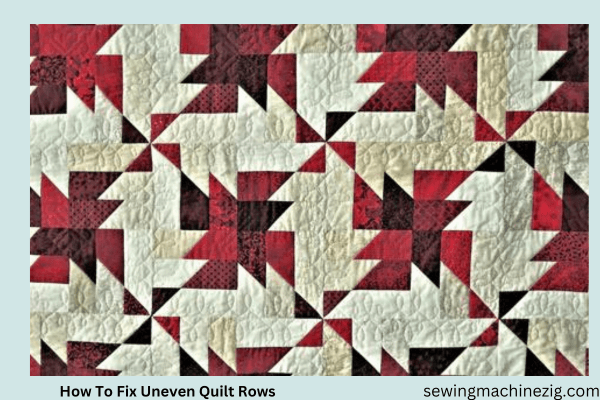
Quilting is a creative and rewarding craft, but sometimes, even with careful planning and precise piecing, uneven rows can throw off the balance of a quilt top. how to fix uneven quilt blocks is a common concern among quilters.
I will teach you how to fix uneven quilt blocks or rows, there are effective techniques to rectify this issue and restore harmony to your project. By employing strategic adjustments and sewing techniques, you can realign and fix uneven quilt rows, resulting in a visually appealing and well-balanced quilt top.
In this guide, we’ll explore step-by-step methods and provide practical examples to help you learn how to fix uneven quilt blocks or rows and address them, overcome the challenge of uneven quilt rows, allowing your quilting masterpiece to shine.
Materials:
- Quilt top with uneven rows
- Pins
- Sewing machine
- Iron
- Ironing board
- Rotary cutter
- Cutting mat
- Quilting ruler
Step-by-Step Guide:
Step 1: Identify The Uneven Rows:
Examine your quilt top and identify which rows are longer or shorter than the others. Let’s say Row 2 is shorter than Row 1 and Row 3.
Step 2: Pin And Adjust:
Take Row 2 and pin it to Row 1, aligning the seams and edges. Start pinning in the middle and work your way towards each end. Leave about 1/4 inch of fabric from the left and right edges when pinning.
Step 3: Sew With Accurate Seam Allowances:
Using a 1/4 inch seam allowance, sew Row 2 to Row 1. Sew slowly and avoid stretching or pulling the fabric. Leave about 1/4 inch of fabric from the left and right edges when sewing.
Step 4: Press The Seam:
After sewing, press the seam flat with an iron. Set the seam by placing the iron on the seam for a few seconds, then open the fabric and press the seam to one side or press it open. This helps set the seam and reduces puckering.
Step 5: Pin And Adjust The Next Row:
Take Row 3 and pin it to the newly sewn Row 1-2 combination, aligning the seams and edges. Start pinning in the middle and work your way toward each end. Leave about 1/4 inch of fabric from the left and right edges when pinning.
Step 6: Sew With Accurate Seam Allowances:
Using a 1/4 inch seam allowance, sew Row 3 to the Row 1-2 combination. Remember to leave about 1/4 inch of fabric from the left and right edges when sewing.
Step 7: Press The Seam
After sewing, press the seam flat with an iron. Set the seam and press it to one side or open it, just like in Step 4.
Step 8: Repeat The Process
Repeat steps 5-7 for any remaining uneven rows, adjusting and sewing them to the previous rows until all the rows are even.
Example: Let’s say your quilt has 5 rows, and Row 4 is shorter than Row 3 and Row 5. When pinning Row 4 to the Row 3-5 combination, you would align the seams and edges and leave about 1/4 inch of fabric from the left and right edges. Sew with a 1/4 inch seam allowance, press the seam, and repeat the process for any additional uneven rows.
By following these steps and maintaining consistent seam allowances and fabric placement, you can successfully fix uneven quilt rows.
Remember to leave approximately 1/4 inch of fabric from the left and right edges when pinning and sewing to allow for accurate adjustments and a clean finish. how to fix uneven quilt blocks involves paying attention to the details and giving yourself enough room to make necessary corrections. By leaving this small margin, you provide flexibility for aligning and reshaping the blocks as needed.
Why Are My Quilt Blocks Wonky?
Quilting is a meticulous craft that requires precision and accuracy. However, sometimes, despite our best efforts, we end up with wonky quilt blocks. These blocks may be frustrating, but they are a common occurrence for both novice and experienced quilters.
Wonky quilt blocks can throw off the balance and symmetry of your quilt top, making it challenging to achieve the desired outcome. There could be various reasons why your quilt blocks are wonky, ranging from inaccurate cutting to improper sewing machine tension.
In this guide, we will explore the common causes of how to fix uneven quilt blocks or wonky quilt blocks and provide practical solutions to help you achieve beautifully straight and well-constructed blocks.
Solutions:
1. Accurate Cutting:
Ensure precise cutting of fabric pieces by using a rotary cutter, a quality cutting mat, and accurate measurements. For example, if you need 4-inch squares, double-check the measurements and use a ruler to guide your cuts.
2. Consistent Seam Allowance:
Maintain a consistent 1/4 inch seam allowance throughout your piercing. Use a quilting foot with a built-in guide or mark your sewing machine to help you sew with accuracy. For instance, use washing tape as a visual guide to ensure a consistent seam allowance.
3. Proper Fabric Handling:
Be mindful of fabric stretch, especially with bias-cut pieces. Handle the fabric gently and avoid stretching it while sewing. Pin or baste the fabric pieces to secure them without distorting the shape.
4. Sewing Machine Tension:
Check your sewing machine’s tension settings. Improper tension can cause wonky blocks. Thread the machine correctly and adjust the tension according to the fabric you’re using. Test the tension on scrap fabric before sewing your blocks.
5. Precise Pressing:
Press fabric and seams accurately to achieve straight blocks. Use an up-and-down motion when pressing, avoiding dragging the iron. If necessary, use a pressing cloth to protect delicate fabrics. Press seams to one side or open them, depending on your quilt pattern.
6. Accurate Block Construction:
Follow your quilt pattern instructions carefully. Double-check measurements and ensure accurate block construction. For example, measure block components before sewing to verify they match the required dimensions.
Example: Let’s say you’re working on a nine-patch block consisting of nine 3-inch squares. However, your quilt blocks are turning out wonky. Here’s how you can address the issue:
7. Check Your Cutting:
Measure and cut each square to precisely 3 inches using a rotary cutter and ruler.
8. Maintain Consistent Seam Allowance:
Use a quilting foot with a built-in 1/4 inch guide or mark the correct seam allowance on your machine. Sew each seam with a consistent seam allowance to ensure accuracy.
9. Handle Fabric With Care:
Avoid stretching the fabric while handling or sewing. Pin the squares in place to prevent distortion.
10. Adjust Sewing Machine Tension:
Ensure the tension on your machine is appropriate for the fabric you’re using. Test on scrap fabric and make adjustments as needed.
11. Press Seams Accurately:
Press each seam carefully, setting the seam and pressing to one side or opening as required by your pattern.
12. Verify Block Measurements:
Double-check the measurements of each block component before sewing to ensure they align properly.
By following these solutions and paying attention to detail, you can overcome the wonky quilt block issue and learn how to fix uneven quilt blocks, and achieve straight, precise, and well-constructed blocks.
Remember to practice and be patient, as improving quilt block accuracy often comes with experience.
How Do You Stabilize A Quilt Block?
Stabilizing quilt blocks is a crucial step in the quilting process that ensures the integrity and longevity of your finished masterpiece. By implementing effective stabilization techniques, you can enhance precision, prevent distortion, and add durability to your quilt blocks.
Whether you’re a novice quilter or a seasoned enthusiast, understanding how to stabilize quilt blocks will greatly contribute to the overall success of your quilting project.
In this article, we will explore various methods and techniques that can be employed to stabilize quilt blocks or how to fix uneven quilt blocks, allowing you to create beautiful, professional-looking quilts that will withstand the test of time.
Materials:
- Quilt Blocks
- Stabilizer (Interfacing Or Foundation Paper)
- Scissors
- Iron And Ironing Board
Step-By-Step Guide:
Step 1: Assess Your Quilt:
Block Examine your quilt block to determine its specific needs for stabilization. Consider factors such as fabric type, block size, and complexity. This will help you choose the appropriate stabilization technique.
Step 2: Choose The Right Stabilizer:
Select an appropriate stabilizer based on your quilt block’s needs. Common options include interfacing (fusible or sew-in) or foundation paper. Consider the weight and stiffness of the stabilizer, ensuring it provides the necessary support without being too rigid.
Step 3: Cut Stabilizer Pieces:
Cut the stabilizer material (interfacing or foundation paper) into pieces that match the size of your quilt block. Leave approximately ½ inch of extra stabilizer beyond the edges of the block on all sides. This ensures ample coverage for stabilization.
Example: If your quilt block measures 10 inches square, cut the stabilizer to a 10.5-inch square.
Step 4: Position The Stabilizer:
Place the cut stabilizer on the backside of the quilt block, aligning the edges. Ensure that the stabilizer covers the entire block area and extends beyond the edges evenly.
Step 5: Fuse Or Baste The Stabilizer:
If using fusible stabilizer (interfacing), follow the manufacturer’s instructions to fuse it onto the back of the quilt block. Use an iron set to the appropriate temperature.
OR
If using foundation paper, secure it to the back of the quilt block by basting along the edges or using temporary adhesive.
Step 6: Trim Excess Stabilizer:
Using scissors, carefully trim the excess stabilizer from the edges of the quilt block. Leave a small margin of stabilizer (around ¼ inch) beyond the block’s edges to ensure stability.
Example: Trim the stabilizer to be ¼ inch beyond the quilt block’s edges, creating a clean and neat finish.
Step 7: Press The Block:
With the stabilizer attached, gently press the quilt block from the front using an iron set to the appropriate temperature for the fabric. This helps to ensure a flat and smooth surface.
Step 8: Continue Quilt Block Assembly:
Proceed with piecing or appliquéing your quilt block as desired, taking care to follow the pattern or design instructions. The stabilizer will provide added support and stability throughout the process.
Step 9: Remove Excess Stabilizer (If Applicable):
After completing the quilt block assembly, remove any remaining foundation paper or excess stabilizer that is not intended to be part of the final quilt. Carefully detach it from the fabric, being mindful not to damage or distort the block.
Example: Remove any foundation paper used in foundation paper piecing or excess fusible stabilizer beyond the block’s edges.
By following these steps and adjusting the dimensions as per your specific quilt block, you can easily learn how to fix uneven quilt blocks and effectively stabilize your quilt blocks, ensuring they maintain their shape, withstand handling, and contribute to the overall durability and professional finish of your quilt.
How To Square Up A Rectangle Quilt Block?
Achieving precise and accurately sized quilt blocks is essential for a polished and professional-looking quilt.
When working with rectangle quilt blocks, squaring up becomes an important step in ensuring that the edges are straight, corners are right angles, and the block aligns perfectly with others during assembly. Squaring up a rectangle quilt block involves trimming it to the desired size while maintaining its proportions.
In this article, we will guide you through the process of how to fix uneven quilt blocks on squaring up a rectangle quilt block, equipping you with the knowledge and techniques to achieve well-shaped blocks and enhance the overall quality of your quilt project.
Materials:
- Rectangle Quilt Block
- Ruler With A 90-Degree Angle
- Rotary Cutter
- Cutting Mat
Step-By-Step Guide:
Step 1: Assess The Block:
Examine the rectangle quilt block and identify if it requires squaring up. Look for uneven edges or if the block is larger than the desired finished size.
Step 2: Determine The Desired Size:
Decide on the final dimensions you want your rectangle quilt block to be. Measure the sides of the block and note the measurements.
Example: Let’s say you want your rectangle quilt block to be 10 inches wide and 12 inches tall.
Step 3: Measure And Mark:
Place the quilt block on a cutting mat and use a ruler with a 90-degree angle to measure and mark the desired size on each side of the block. Make sure to leave a margin for trimming.
Example: For a 10×12 inch block, measure and mark 10.5 inches on the left and right sides and 12.5 inches on the top and bottom.
Step 4: Align The Ruler:
Position the ruler along one of the marked lines, ensuring the 90-degree angle aligns with the edges of the block. Double-check that the ruler is straight and parallel to the sides.
Step 5: Trim The Excess:
Using a rotary cutter, carefully trim the excess fabric along the ruler’s edge. Move slowly and maintain firm pressure to ensure a clean and straight cut.
Example: Trim the fabric from the left and right sides, removing the excess beyond the marked lines.
Step 6: Rotate And Repeat:
Rotate the block 90 degrees, aligning the freshly trimmed edge with the ruler. Again, make sure the ruler is parallel to the sides and the 90-degree angle is accurate. Trim the excess fabric.
Example: Trim the fabric from the top and bottom, following the marked lines.
Step 7: Check For Accuracy:
Check that all sides of the block now measure the desired dimensions. If needed, make slight adjustments by trimming small amounts until the measurements are precise.
Step 8: Press And Complete:
Once you have squared up the rectangle quilt block, press it with an iron to flatten and remove any wrinkles or creases. Your block is now ready for assembly with other blocks in your quilt project.
Example: Your squared-up rectangle quilt block should now measure exactly 10 inches wide and 12 inches tall.
By following these steps and adjusting the measurements as per your specific requirements, you can easily learn how to fix uneven quilt blocks on square up your rectangle quilt blocks, ensuring they are uniform, properly sized, and ready for seamless integration into your quilt design.
Conclusion:
Uneven quilt blocks can be a frustrating challenge, but there are effective solutions to rectify the issue and salvage your project.
By addressing the problem early on of how to fix uneven quilt blocks, you can ensure a cohesive and visually pleasing finished quilt. Whether the unevenness stems from mismatched sizes, misaligned seams, or distorted fabric, there are several corrective measures you can employ.
These may include trimming, re-sewing seams, or adding borders to adjust the block size. With patience, attention to detail, and a willingness to make adjustments, you can overcome uneven quilt blocks and achieve a beautiful and harmonious quilt that you’ll be proud to display or gift to others. I hope now you are fully aware of How To Fix Uneven Quilt Blocks.
FAQs:
Q1: My Quilt Blocks Are Different Sizes. How Can I Fix This Issue?
Answer: To fix mismatched block sizes, measure the largest block and trim the others to match its dimensions. Use a ruler and rotary cutter for precise cutting, ensuring all blocks are the same size.
Q2: What Should I Do If My Quilt Block Has Misaligned Seams?
Answer: If the seams are off, carefully unpick the stitches along the affected seam and re-sew, aligning the fabric edges accurately. Press the seam open or to one side, depending on your preferred technique.
Q3: I Noticed That My Quilt Block Is Distorted. How Can I Correct This?
Answer: If a quilt block is distorted, it may have stretched during piecing. Gently steam or press the block, easing it back into shape. Avoid excessive stretching while pressing and handle the block with care.
Q4: Can I Add Borders To Fix Uneven Quilt Blocks?
Answer: Yes, adding borders is an effective way to adjust block sizes and create uniformity. Measure the smallest block’s dimensions and cut border strips to match. Attach the borders, ensuring they are evenly distributed around the block.
Q5: What If My Quilt Blocks Have Uneven Edges?
Answer: If the edges are uneven, use a ruler and rotary cutter to trim the excess fabric and create straight edges. Align the ruler along the desired measurement, ensuring a clean and accurate cut.
Q6: Is It Possible To Camouflage Uneven Blocks With Sashing Or Sashing Strips?
Answer: Yes, sashing can help conceal minor size discrepancies between blocks. Use consistent-width sashing or sashing strips between the blocks to visually unify them and create a cohesive quilt top.
Q7: How Can I Prevent Uneven Quilt Blocks In The Future?
Answer: To prevent uneven blocks, focus on accurate cutting, consistent seam allowances, and careful pressing throughout the piecing process. Take measurements frequently and use pins or clips to secure fabric layers for precise alignment.

